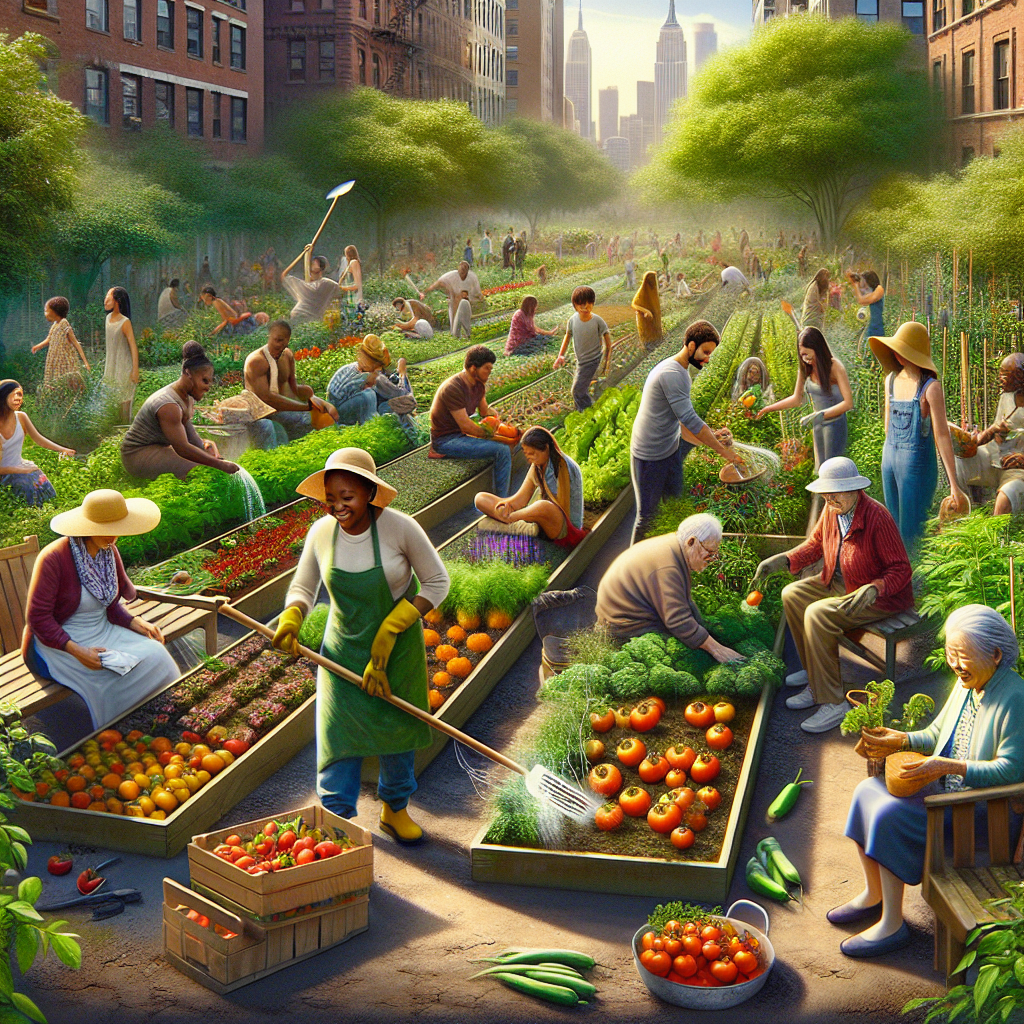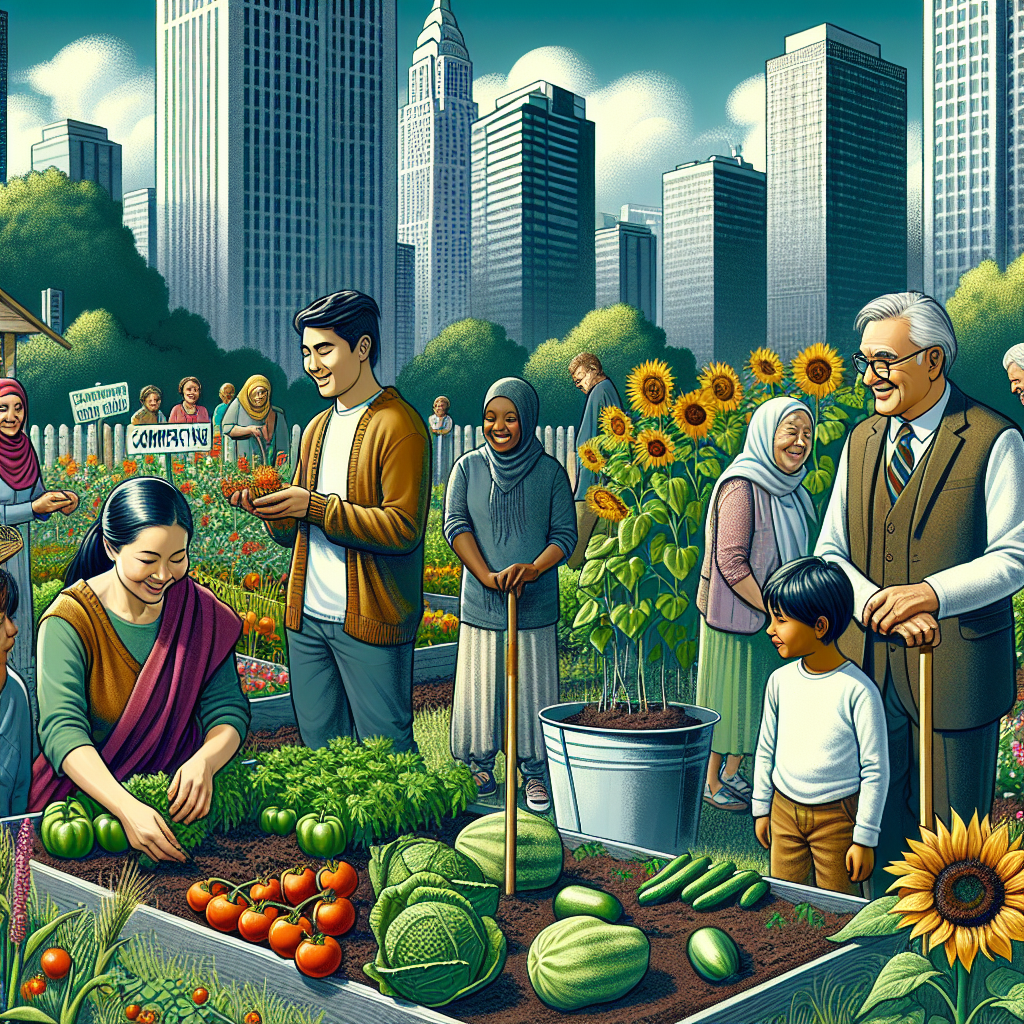
Imagine yourself strolling through a bustling city, surrounded by towering buildings and concrete streets. Amidst this urban jungle, a surprising oasis emerges – a community garden. They have become a growing trend in cities around the world, providing individuals with a space to reconnect with nature, build community bonds, and promote sustainable living. In this article, we will explore the cultural and social impact of community gardens in urban areas, highlighting the myriad benefits they bring to individuals and the broader community. Discover how these green spaces are transforming the concrete jungles into vibrant hubs of social interaction and cultural exchange.

History of Community Gardens
Origins of community gardening
Community gardening has roots that can be traced back to ancient civilizations, where people worked together to cultivate and grow plants for sustenance. In urban areas, the concept of community gardens began to gain prominence in the late 19th and early 20th centuries as a response to the rapid industrialization and urbanization. These gardens served as a way for city dwellers to reconnect with nature, promote self-sufficiency, and contribute to the overall well-being of their communities.
Evolution of community gardens in urban areas
Over time, the significance of community gardens in urban areas has grown exponentially. From their humble beginnings as small patches of green space, these gardens have evolved to become vibrant hubs of social interaction and cultural exchange. The rise of urban agriculture and the increasing awareness of environmental sustainability has further bolstered the popularity and importance of community gardens in today’s society.
The Role of Community Gardens in Urban Areas
Providing access to fresh and affordable produce
One of the primary roles of community gardens in urban areas is to address food insecurity by providing access to fresh and affordable produce. Many urban areas are characterized by food deserts, where nutritious and affordable food options are scarce. Community gardens help bridge this gap by empowering individuals and communities to grow their own fruits and vegetables, promoting healthy eating habits, and ensuring that everyone has access to nutritious food options.
Promoting healthy lifestyles
Community gardens play a crucial role in promoting healthy lifestyles. Through physical activity involved in gardening, individuals can engage in moderate exercise, which contributes to improved cardiovascular health and reduced risk of chronic diseases. Additionally, the consumption of fresh produce grown in community gardens contributes to a well-balanced diet, supporting overall wellness and vitality.
Enhancing urban aesthetics
In addition to providing access to fresh produce and promoting healthy lifestyles, community gardens contribute to the beautification of urban areas. Typically nestled amidst concrete jungles, these pockets of greenery offer a respite from the hustle and bustle of city life. The vibrant colors, diverse plant life, and well-maintained landscapes create a visually appealing environment that enhances the overall aesthetics of the neighborhood and instills a sense of pride within the community.

Creating a Sense of Community
Bringing diverse groups of people together
Community gardens act as a catalyst for bringing together individuals from diverse backgrounds and cultures. Regardless of age, gender, ethnicity, or socioeconomic status, these spaces provide a common ground for people to connect and collaborate. Gardening becomes a shared experience that fosters understanding, compassion, and respect among community members, leading to the formation of strong bonds and a sense of belonging.
Fostering social interactions and connections
Engaging in gardening activities within a community garden setting creates opportunities for social interactions and connections. Whether it’s swapping gardening tips, sharing surplus produce, or working together on common projects, community gardens encourage informal conversations and facilitate the development of new friendships. The social fabric of communities is strengthened as individuals come together to nurture the plants, share experiences, and support each other.
Promoting cultural exchange and understanding
Community gardens provide an ideal platform for promoting cultural exchange and understanding. As people from different cultural backgrounds come together to cultivate their plots, they have the opportunity to share their knowledge, traditions, and customs related to gardening. This exchange of ideas fosters a rich and diverse learning environment, where individuals can appreciate and celebrate the cultural heritage of their fellow gardeners.
Community Gardens as Educational Spaces
Teaching sustainable gardening practices
Community gardens serve as valuable educational spaces where sustainable gardening practices can be taught and shared. From composting and water conservation techniques to organic pest management strategies, individuals can learn how to cultivate plants in an environmentally friendly manner. These practices promote long-term sustainability, reducing the ecological footprint of urban communities and encouraging responsible stewardship of the land.
Providing hands-on learning opportunities
Community gardens offer hands-on learning opportunities for people of all ages, particularly children and young adults. Schools and educational institutions have increasingly recognized the value of community gardens as educational tools to teach students about food systems, ecological processes, and the importance of environmental stewardship. Through active participation in gardening activities, students develop practical skills, critical thinking abilities, and a deeper appreciation for the natural world.
Promoting environmental consciousness
By immersing individuals in the process of growing their own food, community gardens nurture a sense of responsibility towards the environment. The understanding of the interconnectedness between humans and nature deepens as gardeners witness firsthand the impact of their actions on the health of ecosystems. This heightened awareness translates into positive environmental behaviors, such as reducing waste, conserving resources, and adopting sustainable practices beyond the confines of the garden.

Community Gardens and Food Security
Addressing food deserts in urban areas
Community gardens play a pivotal role in addressing the issue of food deserts in urban areas. For many individuals living in impoverished neighborhoods, access to fresh and nutritious food is limited due to the absence of grocery stores or affordable options. By providing a source of locally grown produce, community gardens help address this disparity in access, offering a sustainable solution to food insecurity and promoting equitable food distribution.
Increasing food self-sufficiency
In addition to addressing immediate food needs, community gardens empower individuals to become more self-sufficient when it comes to their food supply. By cultivating their own fruits and vegetables, community gardeners reduce their reliance on external food sources, leading to increased food security and resilience. This newfound self-sufficiency not only provides a sense of empowerment but also contributes to the overall well-being and socioeconomic stability of individuals and communities.
Supporting local food systems
Community gardens contribute to the development of local food systems by producing fresh, nutrient-rich produce that can be utilized within the community. By supporting local farmers’ markets and other distribution channels, community gardeners help build a network that connects producers with consumers, strengthening the local economy and fostering a sense of community pride. The cultivation of local food systems creates a virtuous cycle, where the sustainability of community gardens and the welfare of the community go hand in hand.
Community Gardens and Mental Health
Reducing stress and anxiety
Engaging in gardening activities within the tranquil and natural environment of a community garden has been shown to have significant mental health benefits. The act of gardening itself provides a sense of relaxation and connection with nature, reducing stress and anxiety levels. The rhythmic tasks of planting, weeding, and harvesting serve as a form of mindfulness, allowing individuals to focus on the present moment and find solace amidst the pressures of urban life.
Improving overall well-being
Community gardens have a positive impact on overall well-being by promoting a sense of purpose, accomplishment, and satisfaction. The sense of achievement that comes from nurturing a plant from seed to harvest cultivates a feeling of pride and self-worth. Additionally, the physical activity involved in gardening releases endorphins, improving mood and boosting overall mental and physical well-being.
Creating a therapeutic environment
Community gardens also have the potential to create a therapeutic environment for individuals facing mental health challenges. The act of tending to plants, experiencing the wonders of nature, and engaging in a supportive community can provide a sense of belonging, purpose, and hope. Community gardens can be integrated into mental health programs, providing participants with a safe and nurturing space to heal and grow.

Community Gardens as Catalysts for Economic Development
Creating job opportunities
Community gardens have the potential to create job opportunities and stimulate economic development within urban areas. From garden coordinators and educators to farmers’ market vendors and food entrepreneurs, the various aspects of community gardens create a demand for diverse skill sets. By leveraging the resources and market potential of community gardens, individuals can generate income, contribute to local economies, and foster entrepreneurship.
Boosting local economy through farmer’s markets
Community gardens often serve as hubs for farmer’s markets, providing an avenue for gardeners to sell their harvest and generate income. Farmer’s markets not only create opportunities for local producers to showcase their products but also attract visitors and stimulate economic activity within the surrounding areas. The income generated from these markets injects financial resources into the community, benefiting both gardeners and the wider local economy.
Encouraging entrepreneurship
Community gardens have the potential to serve as incubators for entrepreneurship. By cultivating entrepreneurial skills and fostering innovation, individuals within the community can develop unique business ideas centered around urban agriculture and sustainability. From value-added products made from garden produce to eco-tourism initiatives, community gardens provide a fertile ground for individuals to explore and launch their entrepreneurial endeavors.
Challenges and Potential Solutions
Limited access to land and resources
One of the major challenges faced by community gardens in urban areas is limited access to land and resources. The scarcity of available land and high real estate costs often pose obstacles to the establishment and expansion of community gardens. To overcome this, partnerships between local governments, community organizations, and landowners can be formed to secure accessible land for community gardens. Additionally, resources and funding should be allocated to support the development and maintenance of community garden infrastructure.
Ensuring inclusivity and accessibility
Community gardens must strive to be inclusive and accessible to individuals from all walks of life. Efforts should be made to address barriers to participation, such as language barriers, physical disabilities, or cultural differences. Providing translation services, offering gardening tools and infrastructure that are accessible to individuals with disabilities, and implementing inclusive programming are some ways to ensure that community gardens serve as welcoming spaces for everyone.
Maintaining long-term sustainability
To ensure the long-term sustainability of community gardens, it is essential to establish robust organizational structures and secure ongoing funding. Community garden management committees, partnerships with local organizations, and volunteer networks can help distribute responsibilities and ensure the continued success of these initiatives. Furthermore, engaging with the wider community through education, outreach activities, and events can help raise awareness and garner support for community gardens, fostering a collective sense of ownership and responsibility.

Successful Community Garden Initiatives
Case studies of thriving community gardens
Numerous community gardens across the world have thrived and become integral parts of their respective communities. Examples include the South Central Farm in Los Angeles, California, which transformed an abandoned lot into a thriving urban farm that provided fresh produce to its surrounding community. In Melbourne, Australia, the Collingwood Children’s Farm engages in educational programs and provides opportunities for children to connect with nature and learn about sustainable agriculture.
Best practices and lessons learned
Successful community gardens share common characteristics and best practices that contribute to their longevity and impact. These include strong community engagement, the establishment of partnerships with local organizations and government agencies, clear governance structures, effective communication strategies, and regular maintenance and improvement of the garden’s infrastructure. By studying these best practices and learning from past experiences, communities looking to establish or expand community gardens can enhance their chances of success.
The Future of Community Gardens
Expanding community garden programs
The future of community gardens lies in their expansion and integration into urban planning. As cities become more aware of the benefits of community gardens, there is a growing trend of incorporating them into green space initiatives and urban development projects. By maximizing the use of vacant land, rooftops, and other unused spaces, community gardens can be strategically located throughout urban areas to ensure widespread access and maximum impact.
Integration with urban planning
Integrating community gardens into urban planning is crucial for their sustainability and long-term success. By incorporating community gardens into zoning regulations and land-use policies, cities can facilitate the establishment and protection of these spaces. Urban planners should consider factors such as access to sunlight, proximity to residential areas, and infrastructure needs when designating land for community gardens, ensuring that these spaces are well-integrated into the fabric of the city.
Innovations and technological advancements
The future of community gardens is also closely tied to innovations and technological advancements. From vertical gardening systems and hydroponics to smart irrigation and sensor-based monitoring, technological advancements have the potential to revolutionize urban agriculture. By embracing these innovations and integrating them into community garden practices, cities can maximize productivity, conserve resources, and overcome some of the challenges associated with limited space and resources.
In conclusion, community gardens have a rich history and have evolved to become much more than just spaces for growing plants. They play a crucial role in addressing food insecurity, promoting healthy lifestyles, creating a sense of community, and fostering educational and environmental initiatives. Community gardens also contribute to mental health and well-being, catalyze economic development, and offer solutions to the challenges faced by urban areas. As cities continue to embrace the cultural and social impact of community gardens, the future holds the promise of their expansion, integration with urban planning, and the embrace of innovations to create sustainable, inclusive, and thriving urban communities.





